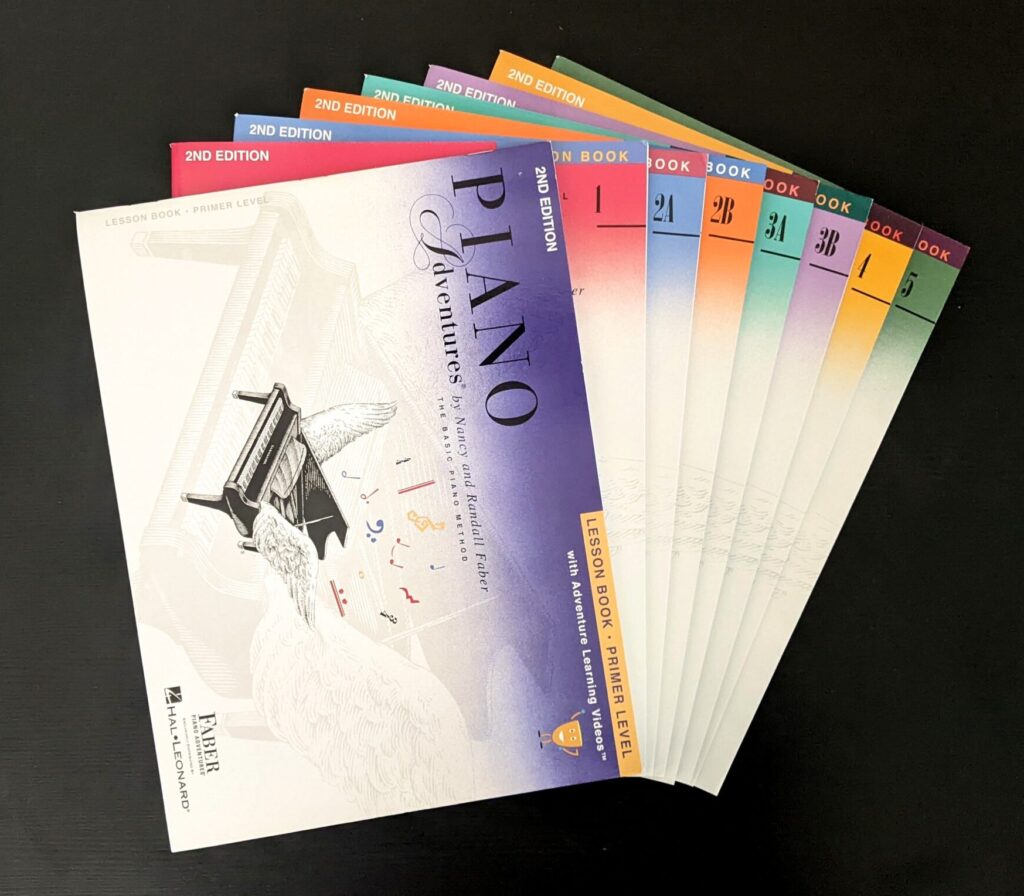
Faber Piano Adventures is a household name among piano teachers in the U.S. If you are a piano teacher looking for the perfect piano method books for a beginning student between the ages of 6 and 12, the Faber Piano Adventures series is definitely worth looking into.
As a veteran piano teacher of nearly two decades, I’m going to walk you through my personal 10 criteria for comparing piano method books.
In this post, I’ll total up the “score” for the Faber Piano Adventures method books while sharing some of my own experiences using these piano method books.
My 10 Categories For Comparing Piano Method Books
When I first started teaching, I excitedly drove down to my local music store to peruse the shelves for beginner level piano method books for my new students. I was overwhelmed by the choices! As I opened each first level lesson book, I thought, “Well, this looks nice. And this one looks good. And I like this one, too.”
In a sea of choices when it comes to beginner level piano method books, having specific categories in place to think about, score, and compare can make all the difference in choosing the best one for you.
Let me share my categories for comparison and then in the next section, we’ll score the Faber Piano Adventures books in all 10 of these categories.
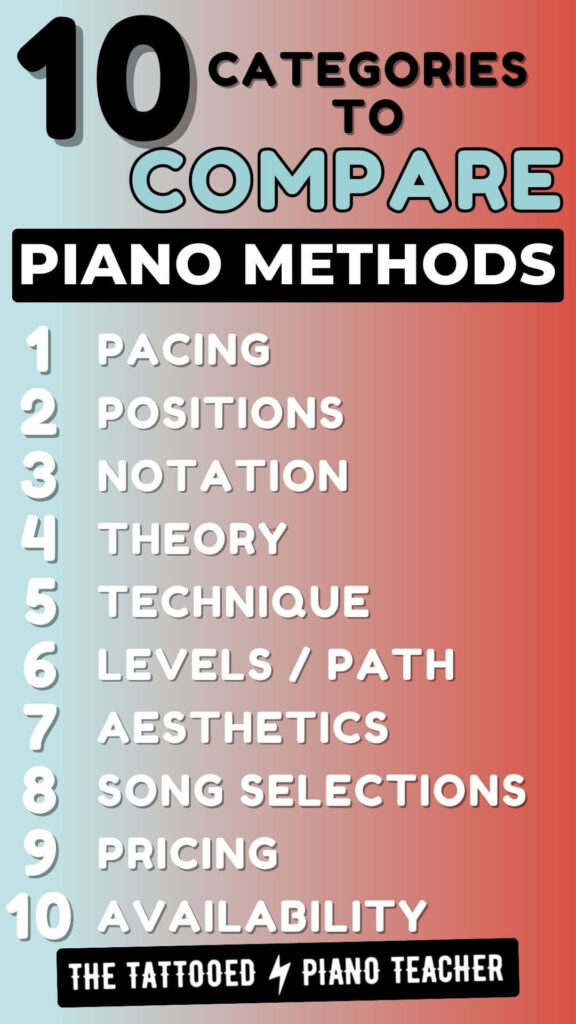
The categories are:
- Pacing
- Postitions
- Notation
- Theory
- Technique
- Levels/Path
- Aesthetics
- Song Selections
- Pricing
- Availability
For a more in-depth explanation of what each of these categories entails, please check out my blog post Best Piano Method Books For Beginners: My Top 3 Picks where I break down each one in detail.
Faber Piano Adventures: An In-depth Review
Now let’s open up the pages of this treasured piano method book series and use the above categories to give us an overhead view of how well this would work for our beginning piano students.
This review is all about the Basic Piano Adventures series. If you’re interested in books for younger or older beginners, or adults…I have specific reviews for those as well!
Other Faber Piano Adventures Review:
- Younger Beginners: My First Piano Adventure series
- Older Beginners: Accelerated Piano Adventures series (blog post coming very soon; I do have a video review)
- Adult Beginners: Adult Piano Adventures All-in-One books
- Comprehensive List of All Faber Method Books
But if you’re new to the world of Piano Adventures, I recommend starting right here on this page as this is a review of the core series of books.
Quick Disclaimer: This post is entirely based on my opinions and personal experience with these books. I understand that other teachers may have a different experience with the books reviewed in this post.
Pacing of Faber Piano Adventures Series: Average Pace
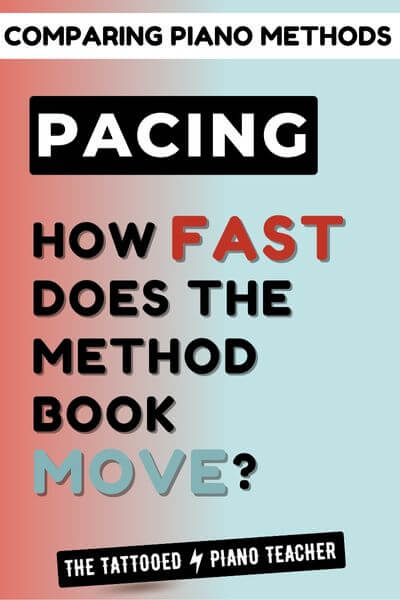
Piano Adventures has become my standard, go-to series because it serves the majority of students in the best way. When in doubt about the pacing needs of a student, Piano Adventures is a great pick to start with.
From page to page, and level to level, there is a nice balance of new and review. Each new concept is introduced and then incorporated into the next few songs. Past concepts are lightly reviewed throughout, with a more in-depth review of theory concepts at the end and beginning of each new level.
Positions: Neighbor Notes Positions and C Pentascale Introduced in the Second Half of the Primer Level
Like many piano method books, in the Primer Level of the Faber Piano Adventures book, students begin by playing songs using only the black keys moving up and down the keyboard. This is beneficial in helping new students navigate the keys and recognize the pattern of two- and three-black-key groups. However, the songs can be tricky to interpret on a small keyboard if students are practicing at home on, say, a 61-key keyboard.
After the white keys are introduced, the student’s hands are kept in either Middle C Positions (thumbs are sharing Middle C), or in what I call “Neighbor Notes” Position (LH thumb on B, RH thumb on C or LH thumb on C, RH thumb on D).

Before staff notation is introduced, students are introduced to the C Pentascale (both hands on C-D-E-F-G).
The rest of the book rotates between the C Pentascale, Middle C Position and Neighbor Notes Positions, with a few variations. Hand moves are indicated with a circle around the finger number.
Notation: Staff Reading Introduced Halfway Through The Primer Level
Off-Staff Notation
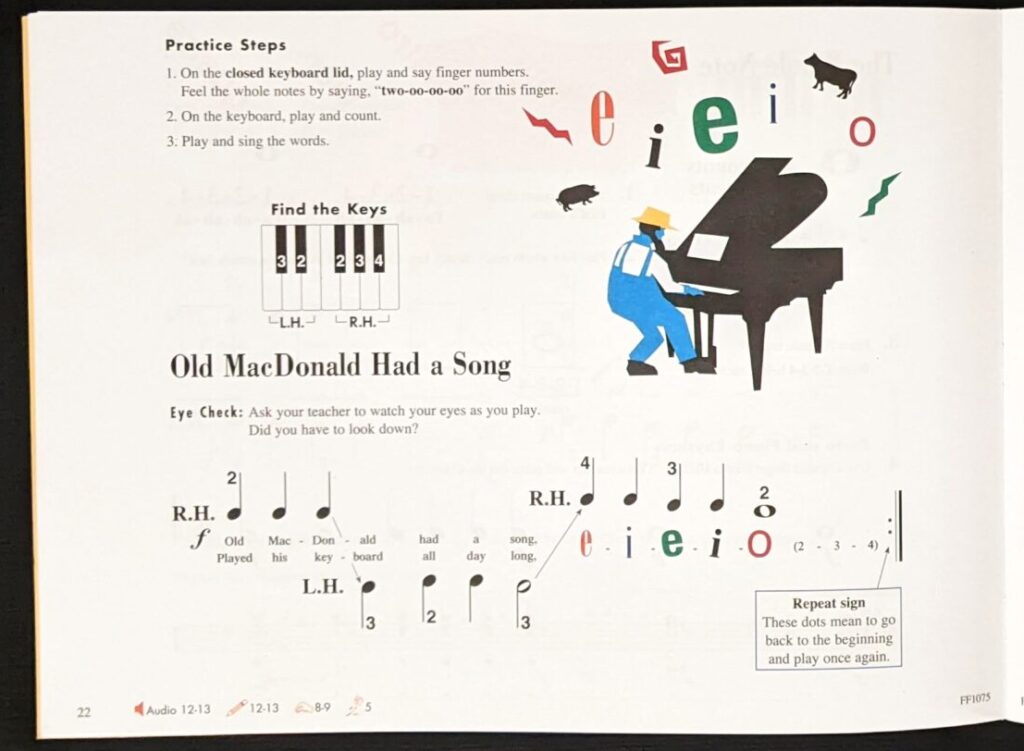
Songs are written in off-staff notation for the first half or so of the Primer Level Faber Piano Adventures books. Staff notation is introduced gradually halfway through.
Staff Notation
The first note learned on the staff is Middle C for both treble and bass clefs. Next, Treble G and Bass F are introduced as guide notes. Then the Treble notes D, E, and F are added. After that, Bass C and D are learned. And finally, Bass E completes the notes learned in the Primer Level of Faber Piano Adventures.

Schedule of New Notes Introduced
In subsequent levels of the Faber Piano Adventures series, notes are introduced gradually by moving students into different scales. Here’s a quick summary of when new positions/notes/pentascales are introduced:
- Primer Level – Middle C Position, Neighbor Notes Positions, C Pentascale
- Level 1 – Treble C Pentascale, G Pentascale
- Level 2A – D Pentascale, A Pentascale, Cm Pentascale, Gm Pentascale, Dm Pentascale, Am Pentascale
- Level 2B – C Major Scale (octave scale), G Major Scale, F Major Scale
- Level 3A – D Major Scale
- Level 3B – A Minor Scale, E Minor Scale, D Minor Scale
- Level 4 – A Harmonic Minor Scale, E Harmonic Minor Scale, D Harmonic Minor Scale, All Major Sharp Keys
- Level 5 – All Major Flat Keys, All Melodic Minor Scales
Notation Pacing of Faber Piano Adventures
Looking at the overall pacing of notation changes, new markings, and, most importantly, the introduction and review of notes on the staff, Faber Piano Adventures maintains an average pace. The amount of time spent going over new notes and concepts is just right for the average student. And there is a moderate amount of review of older concepts.
Lead Sheets
It’s also worth mentioning that each lesson book from Level 2A and beyond includes one lead sheet song as well.

Theory: Separate theory workbook for each level + notespeller books
Faber Piano Adventures Theory Books
The Faber Piano Adventures series offers a separate theory book for each level. The theory books offer a variety of assignments. Here’s a look at what is included in the Faber theory books at every level (click any title to check prices on Amazon):
Primer Level Theory Book
- Black key groups
- Finger numbers
- Note values: quarter, half, whole notes
- Rest value: quarter rests
- Key names
- Notes on the staff: C3-G4
- Skips on the staff
- Ties
Level 1 Theory Book
- Articulations: slur, staccato, accent
- Notes on the staff: F-A-C-E
- Stem direction
- Notes on the staff: C5-G5
- Intervals: 2nd, 3rd, 4th, 5th
- Rest values: half rest, whole rest
- Accidentals: sharp, flat
- Tonic and dominant
- C chord
- I and V7 chord (2-note)
- Notes on the staff: G2-B2
- Upbeat
Level 2A Theory Book
- Note value: eighth notes (paired)
- Accidental: natural
- Transposing
- Dynamics: crescendo, diminuendo
- Articulation: phrase mark
- Intervals: half step, whole step
- D Scale/chord
- A Scale/chord
- Question and answer
- Major and minor
Level 2B Theory Book
- Notes on the staff: C1, C6
- Interval: octave, 6th
- Arpeggio
- Key signatures: C major, G major, F major
- D.C. al Fine
- IV and V7 chord (3-note)
- Notes on the staff: A3-B3 (treble), D4-E4 (bass)
- Musical Form: AB, ABA
- Rest value: eighth rest
- Note value: dotted quarter note
Level 3A Theory Book
- Alberti bass
- Time signature: 2/2, 3/8, 6/8
- Interval: 7th
- Additional musical terms
- Note value: triplet
- Notes on the staff: A1-F2, G5-E6
- Scales: chromatic, whole tone
- Key signature: D major
Level 3B Theory Book
- Key signatures: A minor, E minor, D minor
- Interval: octave, major 3rd, minor 3rd
- Blues progression
- Triad inversions
- Note value: sixteenth note
- Rest value: sixteenth rest
Level 4 Theory Book
- V7 chord (4-note)
- Sequence
- Note value: dotted eighth note
- Key signatures: A major, E major
Level 5 Theory Book
- Cadence
- Time signature: 12/8
- Intervals: perfect, minor, major intervals
- Circle of 5ths
- Key signatures: Bb major, Eb major
Notespeller Books to Go With Faber Piano Adventures
The Fabers have also published a set of notespeller books designed to correlate with the Faber Piano Adventures series. These books include a variety of assignments including naming note writing pages, drawing note writing pages, story fill-in-the-blank pages, and sightreading pages.
I have used all levels of the Faber notespeller books with success in my studio. I like the focus on sightreading as well as the story pages, which students really seem to enjoy. I dislike the way that guide notes are emphasized as I’ve found this approach to be less effective than other approaches. However, that is just a personal preference. I also dislike the “Right Note” and “Wrong Note” score chart at the bottom of certain pages. I would rather work with students to improve on the spot, or emphasize the student’s progress or achievements on the page. I don’t personally like the idea of a black-and-white right-or-wrong mindset.
The books currently available are (click to shop on Amazon):
- I Can Read Music Book 1: Beginning Reading
- I Can Read Music Book 2: Elementary Reading
- I Can Read Music Book 3: Early Intermediate Reading
Technique: Good balance of technical skills to literature ratio
Faber Piano Adventures Technique Books
The Faber Piano Adventures series offers a separate technique book for each level. The technique books, titled Technique & Artistry, give students a variety of assignments. Some pages feature a pattern that the student will move up or down a note. Other pages offer a short etude-type piece focusing on a skill.
There are also a few legitimate pieces labeled “Artistry” assignments. These are usually two-page performance-worthy songs pieces that require a bit of practice to master and highlight artistic details such as dynamics, pedaling, or a hand movement to bring the music to life.
Working through the Technique & Artistry book alongside the Lesson book gives students a steady stream of technical challenges that will serve them no matter which genre they desire to play in the future. Going back to pacing, I find the technique assignments of the Faber Piano Adventures to be moderate paced and well-balanced. I would not say Piano Adventures is a technique-heavy method book series, but I would also not say that students would be lacking in any technical skill after completing the final level.
Technique Within Lesson Books
It’s also important to note the Faber Piano Adventures Lesson books often contain invaluable scale/chord patterns at the back. Lesson Book Level 1, Level 2A, and Level 2B feature this type of appendix giving teachers an easy way to assign technical skills as a warm-up from week to week. I wish the Level 3A through Level 5 Lesson books also had this feature in the back! But these more advanced level lesson books have scale/chord pages throughout the book as new scales or key signatures are introduced.
Skill Sheets to Go With Faber Piano Adventures
These little concentrated skill folios are incredibly motivating for my late elementary to intermediate students. There’s something about having the separate entity outside of the books that seems more special! What’s more, they are even color-coded to correlate to the core method book levels.
Check out the variety of Achievement Skill Sheets here on the Faber Piano Adventures website.
Dedicated Scale Books to Go With Faber Piano Adventures
A few years ago, the Fabers rolled out a series of scale books that are very comprehensive. These are intense and I wouldn’t order these for all of my students, but for the student who wants to really master all things technique (including scales, arpeggios, cadences, and transposing), this may be just the thing.
Shop for Faber Scale and Chord Books on Amazon.
Levels/Path: 8 Levels / Focus on Classical & Jazz & Modern
The Faber Piano Adventures series offers the following levels:

- Primer Level (Purple)
- Level 1 (Red)
- Level 2A (Blue)
- Level 2B (Orange)
- Level 3A (Aqua)
- Level 3B (Purple)
- Level 4 (Gold)
- Level 5 (Green)
Students end the series at an Intermediate level.
Throughout the Piano Adventures series, students are exposed to a variety of styles and genres. Students will exit the series with a good handle on classical, jazz, and modern styles.
This series is truly balanced in that students will get a “little bit of everything” throughout their journey through the books. The Fabers are great arrangers and include folk tunes, familiar traditional melodies, as well as classical literature and jazz, Latin, rock, and pop-influenced songs at each level.
For the average student who doesn’t have a strong pull towards a particular genre or style of playing, the Faber Piano Adventures series offers a great variety to give them a solid foundation to take their playing in any direction upon completion.
Aesthetics: Bright colors, Cute lyrics
The first thing you’ll notice about the Faber Piano Adventures series is the bold colored covers. These distinctive level colors keep students coming back for more! “When do I get to start the aqua books?” I often hear my students say.

What about the interior? Historically, these piano method books had monochromatic, abstract images that left a little to be desired. But I’m happy to report, the authors are systematically updating all of the images in their method books! The new images are more colorful and interesting. My students enjoy them.
The titles and lyrics are interesting enough to keep students engaged.
Song Selections: A good balance between familiar songs & originals; Supplemental choices unsurpassed
Songs Selections Within the Core Faber Piano Adventures Series Books
The Faber Piano Adventures series offers a great balance of classical literature, folk songs, jazz, and modern genres. For the average student, or a student who doesn’t have a specific genre of study, this series of piano method books is the perfect pick to expose them to a variety of styles and techniques.
Faber Supplemental Books
For students who want more exposure to classical literature, supplemental books are available. For those who are interested in jazz, supplemental books are also available. In fact, the Fabers offer an unprecedented volume of supplemental books! For most levels of their Piano Adventures piano method series, you can order a level-appropriate supplemental book in the following genres (click to shop on Amazon):

- Disney
- Hits
- Popular
- Jazz & Blues
- Classics
- Kids’ Songs
- Rock ’n Roll
- Ragtime
- Music From China
- Favorites
- Hymns
- Christmas
- Studio Collection (bestsellers from the above categories)
- Jewish Favorites (Level 2B only)
Faber Piano Adventures Pricing: Around $10/book
Publisher Prices

At retail price, the set of four core Faber Piano Adventures Primer Level books are priced at $9-10 per book.
Ways to Save on Faber Piano Adventures
Amazon
Amazon often has a deal on one or all of these books when purchased separately. Check out their current prices here:
- Lesson Book – Check Amazon Price
- Theory Book – Check Amazon Price
- Technique & Artistry Book – Check Amazon Price
- Performance Book – Check Amazon Price
Often there are sellers offering a discount when purchasing the set of four core books at once.
SheetMusicPlus
SheetMusicPlus.com offers occasional sales on piano method books (sometimes up to 40% off) as well as 8% cash back rebates for music teachers.
On top of the 8% rebate, you can also earn 4% back on all SheetMusicPlus purchases through Rakuten, my favorite no-fuss cashback browser extension that pays you to shop online. (Check out Rakuten here.)
You will pay shipping on SheetMusicPlus purchases, but it is reasonable.
Here’s a link to check out the prices at SheetMusicPlus (and see if they are currently having a sale!):
EveryMusicBook
A “best kept secret” in the piano teacher world–EveryMusicBook.com! Here you can get 35% off Faber Piano Adventures piano method books! Free shipping when you spend $25 on their site. With the 35% discount, you can get the Piano Adventures Primer Level books for:
Get 35% off the four core Primer Level books.
Local Music Store
And your local music store may offer a discount for piano teachers as well. It’s great to connect with your local music store anyways! Often they will offer workshops for piano teachers and other promotional events.
Availability: 10/10
Faber Piano Adventures is the most popular piano method book series and is readily available wherever music books are sold! You can purchase Piano Adventures books at:
Do I Recommend Faber Piano Adventures?

Yes, I do! I use the Faber Piano Adventures series more than any other piano method books in my studio. For most students, they are a wonderful path from complete beginner to competent pianist.
I definitely think the Faber Piano Adventures books are worth checking out. With so many supplemental options, online support, recordings, and videos, you really can’t go wrong with trying out these books.
What Other Piano Method Books Would You Recommend?
Still want to browse for other options? I get it! I like to shop around before making a decision too.
Check out my blog post: Best Piano Method Books For Beginners: My Top 3 Picks.
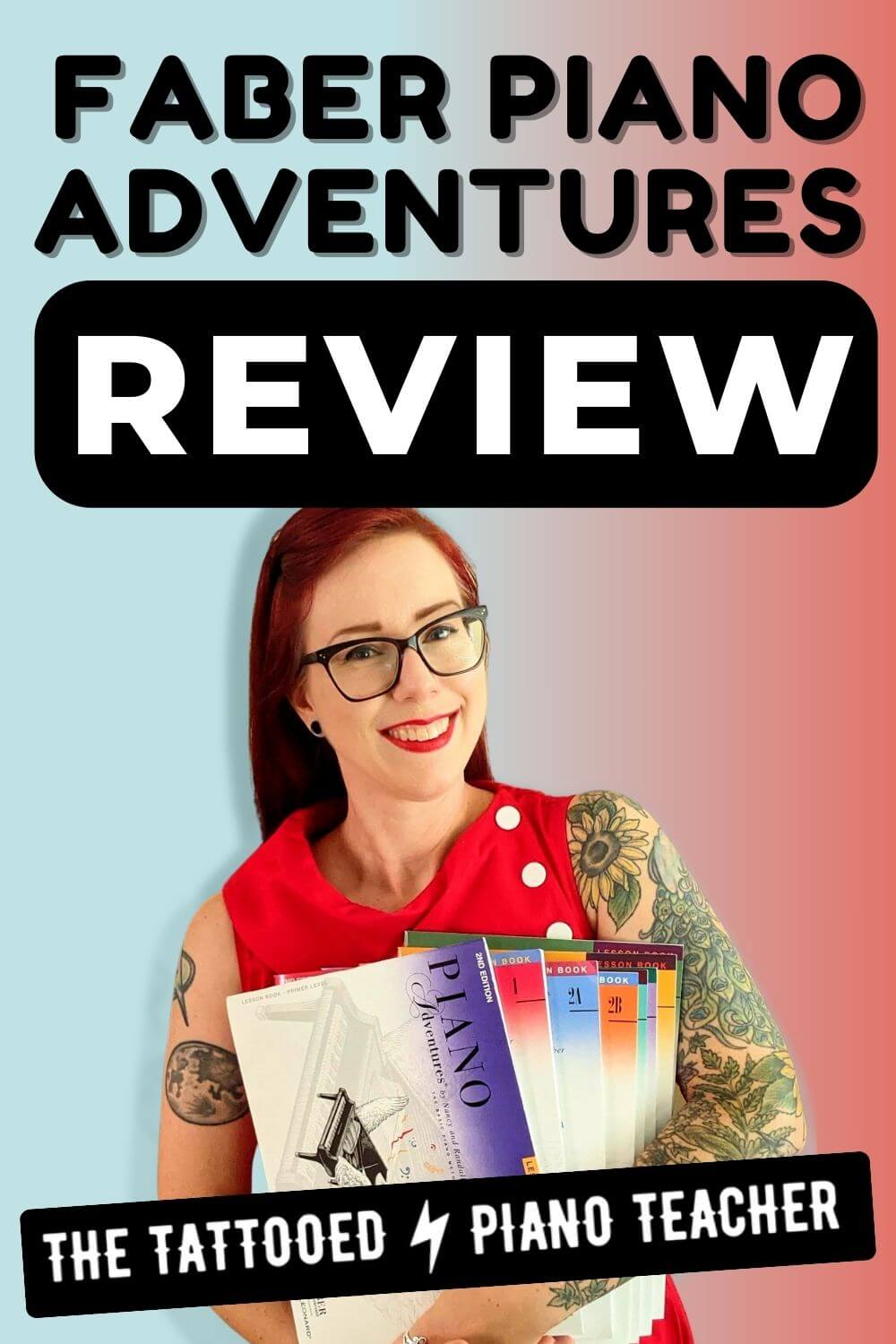
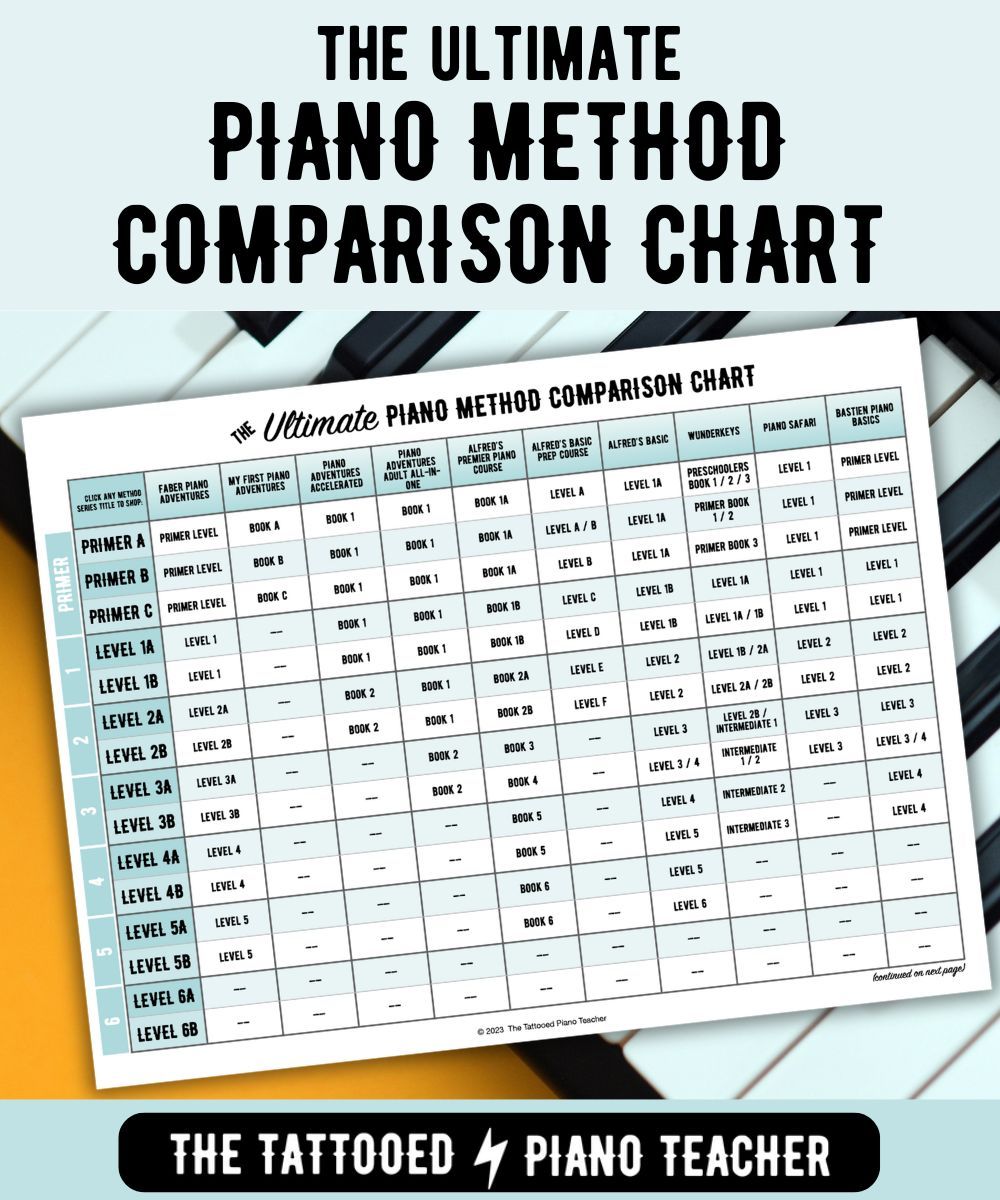
11 Responses